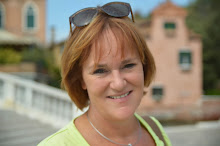During a study day on art education our teachers made portraits of wire. This can also be done in higher grades. If you want to make wire figures in lower grades, then choose a simpler shape, for example fruit/veggies or an animal.
This activity can be done in a lesson about Alexander Calder, known for his wire portraits and mobiles.
You need:
- 3 meters wire thickness 1,3 mm
- wire cutter
- printed selfie 30 by 40 cm
- black marker
- painters tape
Take a picture of yourself and print it.
Outline your face, eyes, nose, mouth and hair using the black marker. Turn the sheet over, the lines can be seen on the back of it now.
Wrap 3 m of wire around your fingers into a bunch.
Start at the neck. Lay the wire flat on the photo and follow the lines of your face. Try to lay out the portrait without cutting the wire. If this doesn't work out, you may smuggle by cutting the wire and go on with a new piece. Give the portrait more strength by doubling the wire on some places. Stick the wire now and then on the photo with painters tape.
Finished? Remove the pieces of tape. Fix the places where wire comes up by making connections with small pieces of wire. See detail photo.




























